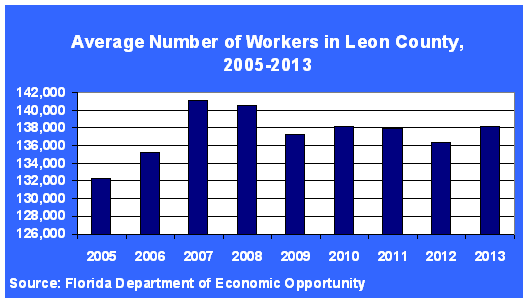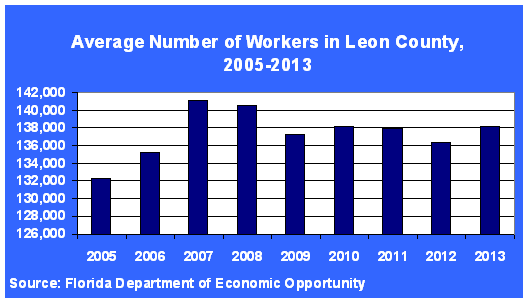The unemployment rate is one of the most watched economic statistics. And with the slow creation of jobs during this longer than normal recovery from the Great Recession, it has become even more visible.
The media and political pundits wait each month for the unemployment rate to be revealed and begin writing about the implications for the recovery.
However, the unemployment rate can also be one of the most misleading economic statistics. A favorable rate can actually occur with a combination of fewer people seeking work and less people actually working. Ultimately, the economy is impacted by the number of people working.
The chart, “Average Number of Workers in Leon County, 2005-2013”, shows that the Great Recession hit Tallahassee’s work force in 2008 and 2009.
In 2007, Leon County had 141,132 people working and had a history of adding approximately 2500 new workers each year since 1990.

In 2009 the number of workers in Tallahassee reached a post-recession low of 137,287. Leon County lost approximately 4,000 workers in 2008 and 2009. The loss of those workers over this period equates to the loss of over $1 billion in annual income.
The chart also shows that our recovery since 2008 has been inconsistent. In fact, the number of workers increased in 2010 and held steady in 2011, but reached a new post-recession low in 2012, with 136,378 people working. This picture quickly changed in the beginning of 2013 with 138,312 people employed.
Based on the latest numbers, Leon County has recovered just over 1000 of the jobs lost during 2008 and 2009. This leaves Leon County some 3000 jobs below pre-recession levels.
However, August 2013 employment data show an improving trend. The “Jobs Added” chart, to the right, shows that Leon County has added 3,205 jobs over the last 12 months, with just over 2,000 jobs coming in the last three months.
These trends indicate that 2013 provides the best opportunity in five years for the local economy to create distance from the lingering effects of the Great Recession. But the “Jobs Added” chart offers a sobering reminder of how quick the employment picture can change in just one month.


